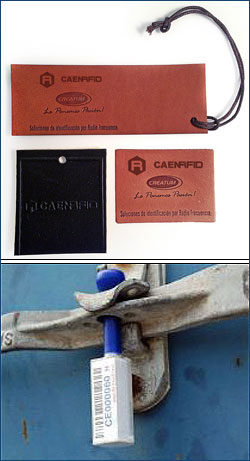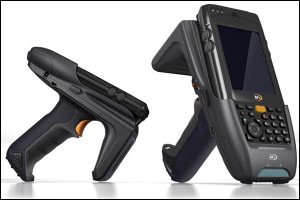The following are news announcements made during the past week by the following organizations: CAEN RFID; iDTronic; the New York Palace; HID Global; Novadis; the U.S. Food and Drug Administration; and Visa Europe.
CAEN RFID Intros New Specialty UHF RFID Tags, UHF E-Seal, UHF Reader Gate/Portal
CAEN RFID has announced a new family of RFID specialty tags for a variety of automatic-identification applications in fashion, food, manufacturing, public administration, logistics, transportation and other applications, as well as a new ultrahigh-frequency (UHF) electronic seal (e-seal) and a UHF reader gate. The specialty tags are available with any EPC Gen 2 and ISO 18000-6C standard inlay from Avery Dennison, Alien Technology, Smartrac, Lab ID or Invengo Technology Corp. The tags can be made of a variety of materials, such as leather, satin, canvas, rubber, cardboard polyvinyl chloride (PVC), canvas, polypropylene, silicone, acrylic resin and mixed materials. The tags are available in any shape and size, flexible or rigid, the company reports; they can have holes for hanging or adhesive backing, can be reinforced for sewing and are washable. Other features—such as the ability to withstand extreme temperatures, chemicals and industrial applications, including washings—are also customizable. The fashion tags can also be integrated into clothing and accessories, such as jeans labels, jacket badges, price labels, and garment wash-care labels, CAEN RFID notes. The special tags for security and traceability in transport—the RFID E-seal—is designed for use only once on a container, as a protection system for monitoring any tampering, in order to ensure the container’s integrity. It shares information about the container as it passes a reader device, and ceases functioning if it is found to have been tampered with. The device complies with the EPC Gen 2 and ISO 18000-6C RFID standards, as well as the ISO 17712 mechanical-seal standard, which defines specifications for mechanical freight container seals. It leverages Impinj‘s Monza 4 or Alien’s Higgs-4 chip, and offers a read range of up to 3 meters (9.8 feet) when read with a handheld, and up to 10 meters (32.8 feet) using a fixed reader. The e-seal is available in multiple colors, and can be delivered pre-printed with a customer’s logo, as well as bar-code and human-readable data. CAEN RFID has also unveiled the Quantum, a UHF RFID reader gate/portal for access-control and access-tracking applications. The device supports the EPC Gen 2 and ISO 18000-6C standards, and has ports for Ethernet, RS232 and RS485 connections. Additionally, it has an integrated three-dimensional reading antenna and can be installed in doorways, corridors or any other transit zone. The gate structure is composed of two vertical metal panels, CAEN RFID reports, each incorporating a special antenna that allows a 3-D reading of the tags, independent of their orientation. On-panel sensors are able to detect both transit direction and missing UHF tag reads. An internal control system manages the gate’s RF emission, the signals coming from the sensors and the signals to the gate’s lamps and acoustic alarm. Aside from operating as a gate, the Quantum can also work in standalone mode, using the internal Intel Atom processor (based on Linux Debian). The Quantum has an optional GPRS modem and Wi-Fi connectivity.
IDTronic Intros RFID Wristbands, UHF Reader Gun
IDTronic has announced the Evolution, an RFID-enabled wristband designed for a variety of uses, including access control for waterparks, gyms, stadiums and sporting events, as well as cashless payments, documentation and entry to keyless locker systems. The wristband is available with a 125 kHz chip—either EM Microelectronic‘s EM4200 or NXP Semiconductors‘ Hitag 1 or Hitag S2048. The Evolution is also available with an NXP 13.56 MHz chip, either the Mifare MF1550 (compliant with the ISO 14443A standard) or the I-Code SLI (complaint with the ISO 15693 standard). The band itself is composed of extremely tear-resistant polyvinyl chloride (PVC) material, and has a closure made of stainless steel with no moving parts. The band is available in different colors in two sizes (women’s and men’s), and can be customized with silkscreen printing using up to three different colors. IDTronic has also announced its M3 Orange UHF RFID Gun, based on the company’s M3 Orange mobile terminal combined with an ultrahigh-frequency (UHF) RFID module. This add-on UHF RFID GUN module has been designed to provide long-range reading—up to 10 meters (32.8 feet)—for ISO 18000-6C tags and labels, according to the company. The M3 Orange mobile terminal and RFID module can be easily separated, the company reports, thanks to the module-based architecture, thereby giving customers more flexibility. The integrated 5,200 mAh battery of the pistol grip and the standard 3,300 mAh battery of the M3 Orange support a range of applications. The M3 Orange features an Intel X-scale PXA270 624 / 806 MHz processor, a Microsoft Windows Mobile 6.5 operating system and a range of options, such as a Wi-Fi 802.11b/g interface, a 1D laser scanner or a 2D bar-code imager and position tracking via GPS.
The New York Palace Streamlines Uniform Care With RFID
A $140 million renovation at the New York Palace, located in Manhattan, has opened the door to an RFID initiative designed to automate the hotel’s uniform system that delivers garments to more than 1,000 employees. The New York Palace, which has 813 guest rooms, 86 suites and 22,000 square feet of meeting and event space, has installed an ultrahigh-frequency (UHF) RFID-based tracking system supplied by InvoTech Systems, a provider of linen and uniform inventory-control solutions for hotels, casinos, resorts, theme parks and sports arenas. The implementation also includes White Conveyors‘ U-Pick-It automated uniform-delivery system; together, InvoTech Systems explains, the two solutions will help reduce labor and operating expenses, by automating the management of more than 10,000 uniforms. “With the New York Palace’s renovations, our goal was to not only modernize and enhance the luxury property, but also implement processes that would streamline our efforts and improve our bottom line, lessoning overall expenses,” said David Chase, the hotel’s GM, in a prepared statement. “InvoTech’s Uniform System helps us find efficiencies and create savings in our labor costs, while providing staff uniforms in an innovative and organized manner.” Oswald Lares, InvoTech’s director of sales, added in the statement that the combination of its Uniform System with the U-Pick-It uniform delivery system “puts clean uniforms in staff’s hands in less than a minute after an employee ID is presented.” The implementation leverages Impinj‘s Speedway Revolution RFID readers and Fujitsu Frontech North America‘s RFID laundry tags. AJ Conveyor and Laundry Systems oversaw the design and installation of the hotel’s uniform conveyor system. Other adopters of InvoTech’s solution include the Ho Tram Beach Resort, in Vietnam, which recently implemented the system (see RFID News Roundup: Vietnam’s Ho Tram Beach Resort Automates Uniform Management With RFID).
HID Global Announces ATEX Certification for RFID Transponders
HID Global has announced that its Logi Tag family of durable RFID tags has achieved ATEX certification. Such certification is achieved by complying with two European Union (EU) directives describing which equipment is allowed within an environment containing an explosive atmosphere. According to HID Global, the certification validates that the tags will operate without danger of directly causing or contributing to an explosion when used at offshore drilling platforms, petrochemical plants, mines, flour mills and other flammable environments. This also extends to other process industries in which there is a mixture of gases, vapors, mists or dust in the air that can ignite at specific temperatures or under certain operating conditions, the company notes. The Logi Tag RFID tags are highly resistant to water, chemicals and shock, and can withstand peak temperatures of up to 285 degrees Fahrenheit (140 degrees Celsius). They are available with either low-frequency (LF) 125 kHz chips or high-frequency (HF) 13.56 MHz chips supporting the ISO 15693 and ISO 18000-3 standards.
Novadis Upgrades Nova-Tag for Industrial Applications
Novadis, a Switzerland-based global developer and manufacturer of fasteners, rubber and plastic components, technical films and industrial packaging and identification solutions, has announced upgraded versions of its Nova-Tag, an ultrahigh-frequency (UHF) passive RFID tag designed specifically for use in tracking goods in the industrial laundry, leather and textile industries, or for any products that undergo chemical and mechanical stresses. The Nova-Tag family of tags now includes chips from Impinj, NXP Semiconductors, STMicroelectronics, and EM Microelectronic, compliant with either the EPC Gen 2 and ISO 18000-6C UHF standards, the ISO 15693 and 18000-3 Mode 1 high-frequency (HF) 13.56 MHz standards, or the ISO 14443A and Near Field Communication (NF) HF standards. The tags are now non-combustible, and are made from specially formulated polymer film that the company claims is extremely resistant to chemicals. According to Novadis, the tags can withstand concentrated acids, alcohols, bases, esters, aliphatic, hydrocarbons, ketones, oils and oxidizing agents. The tags are also now available in a patchable version with a very low bonding temperature and maximum adhesive strength, and can be manufactured in rolls via industrial processing.
FDA Okays RFID-enabled Blood-Tracking Application
The U.S. Food and Drug Administration (FDA) has cleared the use of iTrace for Blood Centers, an RFID-enabled tracking and process automation system designed to improve quality and efficiency in the transfusion medicine supply chain, as well as the safety of the blood supply, by preventing the release of unsuitable blood components. iTrace for Blood Centers is made by SysLogic, based in Brookfield, Wis. The iTrace RFID application is designed to augment existing blood bank systems, and to work in conjunction with bar-code identification and labeling processes currently in place. It leverages 13.56 MHz passive high-frequency (HF) RFID tags complying with the ISO 15693 standard, as well as associated technology to provide visibility to blood products and their location, movement and status. By using RFID technology in concert with bar codes, iTrace for Blood Centers automates blood bag check-in at donor sites, eliminates line-of-sight requirements for checking in blood products to the manufacturing process, and streamlines the process of preparing blood products for shipment to hospitals or transfusion centers, SysLogic reports. iTrace for Blood Centers can increase workflow efficiency, provide increased inventory visibility, and reduce the cost of compliance in blood product tracking and reconciliation, the company adds. The application interfaces with software to receive and store data used by blood establishments during the manufacturing process, including information related to the blood’s collection and component processing, its expiration date and its type (ABO/Rh). The FDA cleared iTrace for Blood Centers based on the submission of a premarket notification, often referred to as a 510(k). The goal of the 510(k) submission process is to demonstrate that the device is at least as safe and effective as—that is, substantially equivalent to—a legally marketed device that had not been subject to a premarket application. In a prepared statement issued by the FDA, Karen Midthun, M.D., the director of the FDA’s Center for Biologics Evaluation and Research, said iTrace can help ensure blood safety, adding that “iTrace for Blood Centers will be used in blood establishments by trained personnel as a tool in streamlining blood collection and processing and aiding in product tracking and reconciliation.” The development of iTrace for Blood Centers was partially funded by two National Institutes of Health (NIH) grants, along with an early grant from the America’s Blood Centers Foundation, a network of nonprofit community blood centers. SysLogic secured the NIH Small Business Technology Transfer (STTR) Phase I and Phase II grants on behalf of the Transfusion Medicine RFID Consortium, a group that includes blood centers, hospitals, RFID systems experts, and research institutions. Prior to seeking 510(k) clearance, the consortium conducted trials of the iTrace system and submitted the results to the FDA (see Consortium Pilot Finds RFID Improves Efficiency of Blood Supply Chain).
Visa Europe Sees Spike in Contactless Payments
Visa Europe has announced that the European usage of contactless payment technologies has reached a critical point of adoption. According to the company, monthly transaction numbers across Europe reached more than 19 million in March, and more than €1 billion ($1.3 billion) has now been spent on contactless cards and smartphones equipped with a Visa payWave application. Overall, there are 58 million contactless cards in Europe, as well as 797,000 point-of-sale terminals that can be utilized by contactless cards and phones with the Visa payWave app. In the United Kingdom, 1.5 million contactless transactions have been made on buses in London so far this year. The company says that in the United Kingdom, one in four Visa cards is now contactless, with 26.9 million in circulation. The country had 5.3 million contactless transactions in March 2013, worth more than £39 million ($51 million), processed by a total of 232,000 terminals. In addition, other countries are also ramping up their use of contactless cards. In France, there are 6.7 million contactless Visa cards, and Visa Europe expects there will be 16 million such cards in the market by the end of this year. In Poland, there are 10 million contactless transactions every month, while in Slovakia, there were 1 million contactless transactions in March. Visa Europe estimates that in Spain, there will be 7.5 million Visa contactless cards by the end of 2013, up from 2.9 million now, and in Turkey there will be 8.5 million in the market by the end of 2013, up from more than 6 million today. By the end of this year, Visa Europe expects the usage rate of its contactless cards to exceed 52 million contactless transactions per month.




